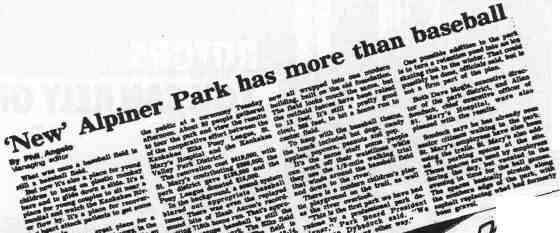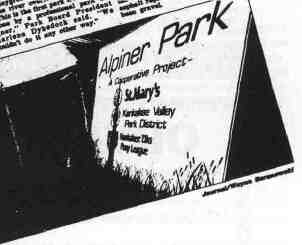Partnerships at Work
park district + private + nonprofit
by Dave Mogle, CLP
At a time when funds were limited and a growing list of capital projects demanded attention, the Kankakee Valley Park District joined together in a unique three-way partnership which resulted in the much needed renovation of the district's Alpiner Park. An agreement among the park district, St. Mary's hospital, and the Kankakee Elks Pony League, made it possible for the four-acre park to receive a $420,000 face lift. The improvements to the park have made it the most modern and attractive of the district's 26 properties.
The focal point of the park is a baseball diamond that is currently the home of the Kankakee Elks Pony League. The ball diamond has been active many years, dating back to 1957. Prior to the renovation, the park was in serious need of repair. The board of commissioners, led by president Charlene Dybedock, designated the park as a prime target for renovation. The baseball field was in poor condition, with inadequate fencing. Two old block buildings, serving as a concession stand and a washroom were deteriorating badly. Neither structure had been maintained throughout the years. A tennis court that was unplayable due to severe cracks, which allowed weeds to grow through, had to be removed, leaving a large unattractive hole filled with gravel where the courts had once stood. An unsightly gravel access road leading to the river cut across the park. Old playground equipment, unused for years, stood in the park near the hospital. Words like "eyesore" and "embarrassment" often were expressed when discussing the park and its problems.
St. Mary's was willing to purchase an equal amount of land in another location for a park in exchange for Alpiner Park. The board at the time considered the sale and made contact with state legislators for guidance and support in the deal. However public outcry from residents surrounding the park, resulted in the hospital and the board reconsidering the sale. Eventually, the hospital backed out of the deal. In 1986 the subject of leasing some of the park land for a parking lot was discussed between the district and St. Mary's, but the proposal died for lack of agreement and concern about public opinion.
Illinois Parks & Recreation * March/April 1996 * 31 In 1993, St. Mary's newest president, Alan Sonduck, approached the district about using a little-used portion of the park next to the hospital for a parking area for 73 cars. The area of the park being sought was just beyond the outfield fence of the ball diamond that was too small to be used for recreational purposes. Sonduck offered to pay for the cost of the construction of the lot plus pay the district for a lease on the lot over the next several years. At this point, the board decided to take a proactive approach and hire a landscape architectural firm to develop a master plan for the entire park, including a parking lot design. The board's position was that if St. Mary's was willing to commit itself to the improvement of the total park, the district might be open to discussing a proposal. The district knew that St. Mary's was primarily interested in a parking lot. However, in approaching an overall plan, thought was given to offer other features that the hospital would also find beneficial to its staff and patients, as well as the general public. This was done to encourage their commitment to a total park renovation. The Pony League was contacted as well seeking their input and possible involvement in a three-way agreement to renovate the park.
Cost figures were put to the plan, which was presented to the hospital and the Pony League showing the improvements the district envisioned and asking how they might help make a total park renovation possible. After adjusting the plan to bring cost estimates to a level with which each organization was comfortable, it became apparent that a project budget of $420,000 would accomplish the renovation. Discussions between the three organizations resulted in apian to move forward with St. Mary's contributing $269,000 covering the cost of the parking lot, walking trails, river overlook, healing garden, and park landscaping. The park district agreed to pay $135,000 for the cost of the new park building, the playground, picnic tables and park benches, and the Pony League agreed to cover the cost of new fencing with a contribution of $16,000.
The park district was responsible for managing the entire renovation. St. Mary's would offer technical assistance from their planning and facility management department. The Pony League agreed to use volunteers to build sinks, cabinets and counters in the new building. All of this was done to keep costs within the budget. The second agreement was a lease agreement with St. Mary's for the non-exclusive use of the parking lot. The parking lot would be built and owned by the park district. The lease established responsibilities for each organization in the operation of the parking lot. For example, the park district would be responsible for the maintenance of the lot and St. Mary's would handle snow removal. The park district and St. Mary's would also plan joint programs in the park. In considering the legal aspects of the lease, the district turned to the Park District Code. Since St. Mary's committed to a substantial contribution to the renovation of the park, the district agreed to a 20-year lease of the lot for $1/year. An opinion from Peter Murphy, general counsel for the Illinois Association of Park Districts, indicated the lease was within the allowances of the Code.
The plan received widespread support overall. After all, the district was taking an "eyesore" park in a very visible area of the city and giving it a total new look. However, there was a small but vocal group who believed that St. Mary's was trying to take control of the park. The opposition appealed to many of the same groups that had successfully killed the sale deal years earlier. Included in the opposition were individuals who, for environmental concerns, did not want to see the construction of a large asphalt parking lot in the park. They expressed concern about the impact on river. In all, four individuals banded together to oppose the plan, citing that when the park land was given to the city, it was with given with the stipulation that it would always be used for recreational purposes. They attempted to annul the project through influencing public opinion against the plan and legal maneuvering. The district and its partners responded by pointing out that this was not the sale of park land and that the recreational possibilities would actually increase because of the agreement. The project received greater positive response from civic leaders and the business community. The local newspaper printed an editorial supporting the plan. The project was pushed along with the thought that as improvements were made, the park would speak for itself. In fact, as the park neared completion, the opposition became quieter.
32* Illinois Parks & Recreation* March/April 1996 Future Cooperation
Through the entire project, the communication between
the district and its partners made the project run quite smoothly.
Representatives of St. Mary's, the park district, and the Elks
Pony League met together frequently to discuss the project
plans and progress. The parties banded together closely when
the opposing forces publicly complained and individually released
news articles to the media supporting the district and the
project. These cooperative attitudes extended beyond the project.
The park distinct jointly ran a health fair with St. Mary's in 1994,
and the hospital became a Pony League sponsor in 1996.
Dave Mogle, CLP, is the executive director of the Kankakee Valley Park District.
Illinois Parks & Recreation * March/April 1996 * 33
|Home|
|Search|
|Back to Periodicals Available|
|Table of Contents|
|Back to Illinois Parks & Recreaction 1996|
|
|||||||||||||||


